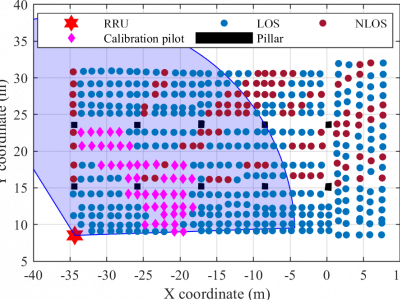5G

The dataset provides an end-to-end (E2E) perspective of the performance of 360-video services over mobile networks. The data was collected using a network-in-a-box setup in conjunction with a Meta Quest 2 head-mounted display (HMD) and a customer premises equipment (CPE) to provide 5G connectivity to the glasses (WiFi-native).
- Categories:
 195 Views
195 Views
This dataset contains results of the 60 GHz indoor sensing measurement campaign using a bistatic OFDM radar based on 5G-specified positioning reference signals (PRSs). The data can be used for testing end-to-end indoor millimeter-wave radio positioning as well as simultaneous localization and mapping (SLAM) algorithms, including channel parameter estimation. Beamformed PRS with dense angular sampling in transmission and reception allows efficient capture of line-of-sight (LoS) as well as multipath components.
- Categories:
 2147 Views
2147 Views
These datasets are collected from the tests that were performed for decentralized synchronization among collaborative robots via 5G and Ethernet networks using with/without causal message ordering. These files have different names depending on the connection type and causality type. For example, 5G_with_causality.txt file stores the test results which were performed on a public 5G network using causal message ordering for different cobot groups like 5,10,20,30,40. The test results for each robot group are separated in each txt file.
- Categories:
 30 Views
30 ViewsAs discussions around 6G begin, it is important to carefully quantify the spectral efficiency gains actually realized by deployed 5G networks as compared to 4G through various enhancements such as higher modulation, beamforming, and MIMO. This will inform the design of future cellular systems, especially in the mid-bands, which provide a good balance between bandwidth and propagation.
- Categories:
 824 Views
824 Views
5G Network slicing is one of the key enabling technologies that offer dedicated logical resources to different applications on the same physical network. However, a Denial-of-Service (DoS) or Distributed Denial-of-Service (DDoS) attack can severely damage the performance and functionality of network slices. Furthermore, recent DoS/DDoS attack detection techniques are based on the available data sets which are collected from simulated 5G networks rather than from 5G network slices.
- Categories:
 4895 Views
4895 ViewsDataset Description:
Based on some real-world events, the dataset offers a synthetic representation of 5G network states and metrics during a high traffic event, such as a major sports gathering in a city. Each row corresponds to a unique record capturing the attributes of the network at a particular moment, and each column corresponds to a specific feature or attribute.
Significance:
- Categories:
 2406 Views
2406 ViewsDataset: IQ samples of LTE, 5G NR, WiFi, ITS-G5, and C-V2X PC5
Thes dataset comprises IQ samples captured from ITSG-5, C-V2X PC5, WiFi, LTE, 5G NR and Noise. Six different dataset bunches are collected at sampling rates of 1, 5, 10, 15 , 20, and 25 Msps. In each dataset cluster, 7500 examples are collected from each considered technology. The dataset size at each considered sampling rate is 7500 X M, where M can be 44, 220, 440, 660, 880, and 1100 for a sampling rate of 1, 5, 10, 15 , 20, and 25 Msps,respectively.
- Categories:
 3790 Views
3790 ViewsThe advancements in the field of telecommunications have resulted in an increasing demand for robust, high-speed, and secure connections between User Equipment (UE) instances and the Data Network (DN). The implementation of the newly defined 3rd Generation Partnership Project 3GPP (3GPP) network architecture in the 5G Core (5GC) represents a significant leap towards fulfilling these demands. This architecture promises faster connectivity, low latency, higher data transfer rates, and improved network reliability.
- Categories:
 3925 Views
3925 Views
The data set contain network survey statistics from the county of Nottinghamshire for four major UK mobile operators. The data are collected from September 2022 till December 2022 and contain both 4G-LTE and 5G-NSA network information and their corresponding GPS location.
- Categories:
 152 Views
152 ViewsChannel frequency response (CFR) dataset used for "In-Situ Calibration of Antenna Arrays for Positioning With 5G Networks" paper (IEEE Transactions on Microwave Theory and Techniques, in print, doi: 10.1109/TMTT.2023.3256532, preprint link: https://arxiv.org/abs/2303.04470).
- Categories:
 2768 Views
2768 Views



